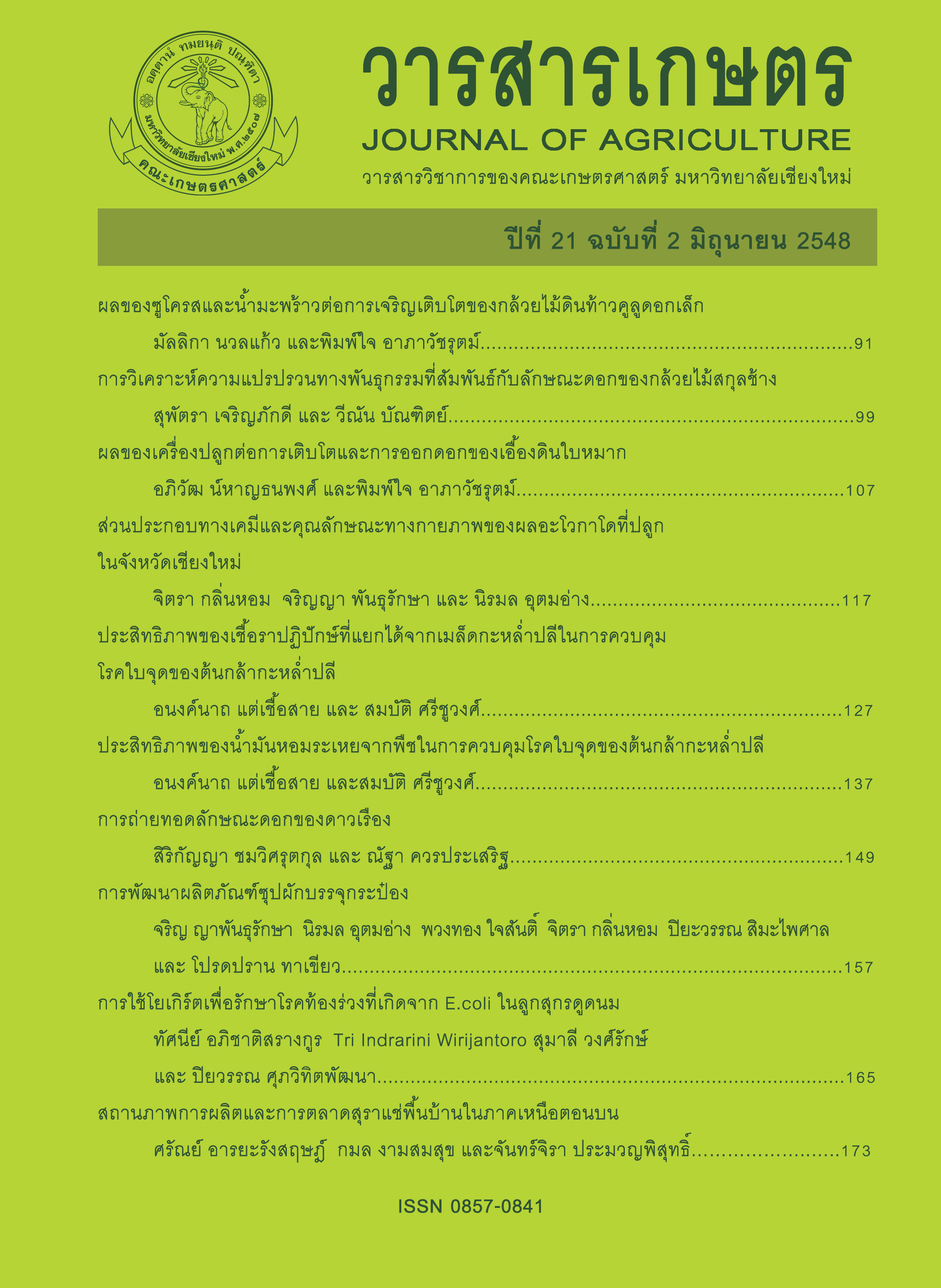Efficacy of Essential Oils from Plants in Controlling Leaf Spot Disease of Cabbage Seedlings
Main Article Content
Abstract
Cabbage seeds cv. No. 1, New Jersey and Ruby Perfection were investigated for Alternaria brassicicola, which causes leaf spot disease, using the Blotter method. Alternaria brassicicola was found in cv. New Jersey more than in the others, viz. in 15.50%. Efficacy test of essential oils extracted from 11 species of plants, in growth inhibition of A. brassicicola mycelia was carried out on PDA mixed with the essential oils. It was found that the oils from Cymbopogon narus, Litsea cubeba, Mentha piperita and Cinnamomum camphora at 1,000 - 2,000 ppm gave 100% inhibition. The essential oils from C. narus and L. cubeba gave similar results in reducing seed infection and increase percentages of seed germination, seedling emergence, normal seedling development, shoot length, fresh and dry weight.
Article Details
References
เกษม สร้อยทอง. 2532. การใช้ Chaetomium cupream ในการควบคุมโรคใบไหม้ของข้าวโพดของข้าวโดยชีววิธี. วารสารโรคพืช 9(1): 28 – 33.
สกุลศักดิ์ โอฬารสกุล. 2540. โรคของพืชประเภทผักและการควบคุม. ภาควิชาเกษตรศาสตร์ คณะเกษตรและอุตสาหกรรมการเกษตร สถาบันราชภัฎลำปาง,ลำปาง. 542 หน้า.
สมบัติ ศรีชูวงศ์ และ อนงค์นาถ แต่เชื้อสาย. 2547. การคัดเลือกเชื้อราที่ติดมากับเมล็ดผักตระกูลกะหล่ำเพื่อนำมาใช้ในการควบคุมเชื้อรา Alternaria brassicicola สาเหตุโรคที่แพร่โดยทางเมล็ดพันธุ์. รายงานการวิจัยฉบับสมบูรณ์ โครงการที่ 3060–3360. มูลนิธิโครงการหลวง, เชียงใหม่.
Adegoke, G.O. and B.A. Odesola. 1996. Storage of maize and cowpea and inhibition of microbial agents of biodeterioration using the powder and essential oil of lemongrass (Cymbogon citratus). International Biodeterioration and Biodegradation 37: 81 – 84.
Agarwal V.K. and J.B. Sinclair. 1996. Principles of Seed Pathology. 2ed. CRC Press, Inc., Boca Raton, Florida. 539 pp.
Basilico, M.Z. and J.C. Basilico. 1999. Inhibitory effects of some spice essential oils on Aspergillus ochraceus NRRL 3174 growth and ochratoxin A production. Letters in Applied Microbiology 29(4): 238 – 241.
Bullerman, L.B., F.Y. Lieu and S.A. Seier. 1997. Inhibition of growth and aflatoxin production by cinnamon and clove oils: cinnamic aldehyde and eugenol. Journal of Food Science 42: 1107 – 1109.
Chatterjee, D. 1990. Inhibition of fungal growth and infection in maize grains by spice oils. Letters in Applied Microbiology 11: 148 – 151.
Dorman, H.J.D. and S.G. Deans. 2000. Antimicrobial agents from plants: antibacterial activity of plant volatile oils. Journal of Applied Microbiology 88: 308 – 316.
ISTA. 1999. International Rules for Seed Testing. International Seed Testing Association, Annexes 1976. Seed Science and Technology 4: 3-49.
Kritzinger, Q., T.A.S. Aveling and W.F.O. Marasas. 2002. Effect of essential oils on storage fungi, germination and emergence of cowpea seeds. Seed Science and Technology 30: 334–336.
Paster, N.M., U.R. Kenasherov and B. Juven. 1995. Antifungal oil applied as fumigants against fungi attacking stored grain. Journal of Food Protection 58(1): 81–85.
Sharma, A., G.M. Lewari, A.J. Shrikhande, S.R. Padwal–Deswal and C. Bandyopadhyay. 1979. Inhibition of aflatoxin – producing fungi by onion extracts. Journal of Food Science 44: 1545–1547.


